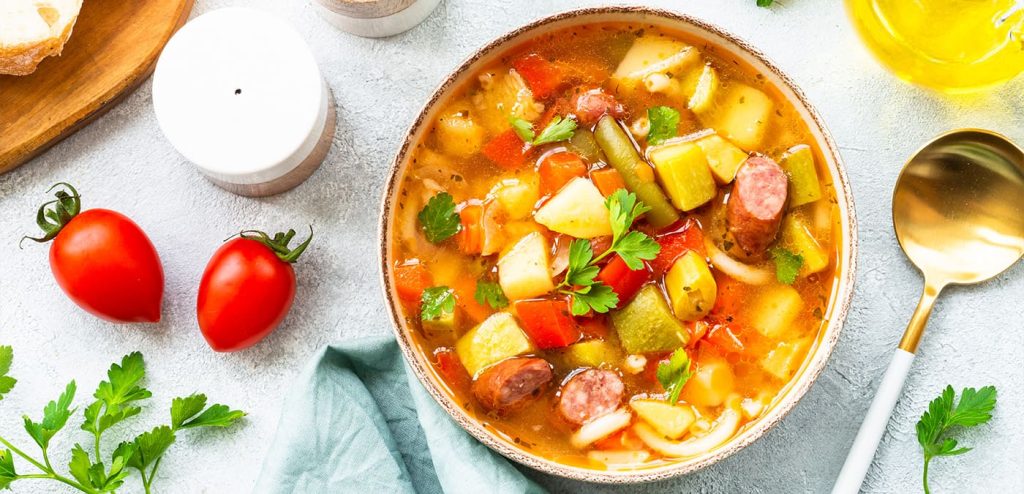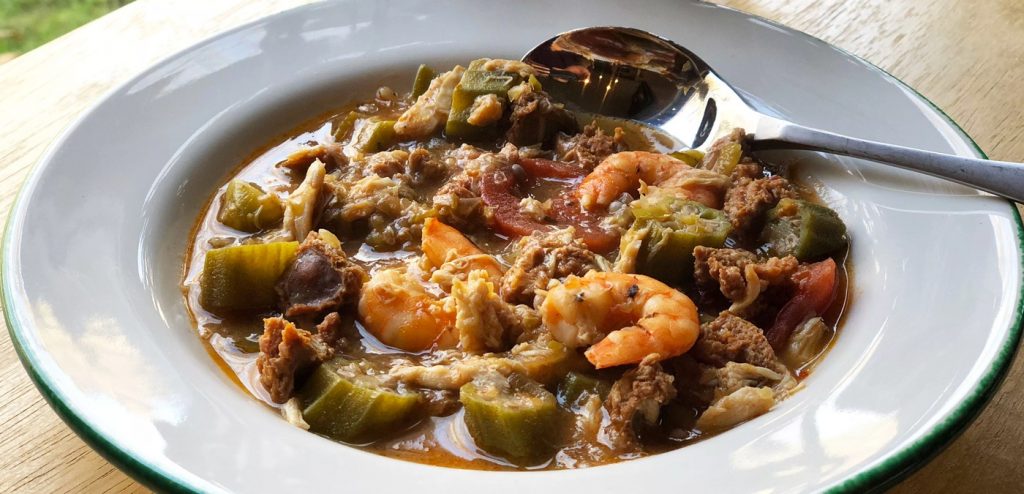
If you love soup so much you eat it all year round, you’ve probably thought about making your own variation of the meal at home. Although soup is easy to make, it can take practice to master. Essentially, you only need a stockpot, water and a few ingredients to cook this meal, but what makes a good soup?
If you’ve ever wondered how to whip up a homemade soup that outshines anything you could get from a restaurant or grocery store, we have soup-making tips and recipes for you. Learn all the tricks to making soup-er soups at home below!
14 Cooking Tips for Great Homemade Soups
Check out these 14 tips to learn how to make homemade soup that tastes like it came straight from a Michelin-starred kitchen:
1. Make Extra
Before getting started on your homemade soup, make sure to get enough ingredients to double the recipe. Along with being easy to make in large batches, soup is one of the easiest foods to freeze. With enough ingredients and a bigger pot, you can make extra homemade soup for a delicious dinner on a busy night when you don’t have the time or energy to cook.
Once you’ve finished making your soup, be sure to let it cool completely to room temperature before storing it in freezer-proof containers.
2. Make Your Own Stock
For clear, brothy soups, stock is your most important ingredient. If you want to make a good soup, you need to use an excellently flavored stock — otherwise, the entire pot could be tasteless. To achieve maximum broth flavor, you can make your own chicken, vegetable, seafood or beef stock. In a pinch, you can usually get away with using a canned broth for cream or pureed soup, but you can’t fake it with a clear soup.
Fortunately, making homemade stock is surprisingly easy. To make chicken stock, for instance, either stockpile chicken bones in your freezer or use ones from a rotisserie chicken. Gather enough to toss in a pot and cover with water. Add in any vegetables, spices or seasonings you would like and allow the mixture to simmer. After several hours, you’ll have a mouthwatering, homemade chicken stock.
3. Chop Ingredients Into Bite-Sized Pieces
When you’re cutting your vegetables and meat in preparation for cooking, consider how large you want them to be on the spoon. Even if you’re making a heartier type of soup, you will still want to have well-chopped ingredients that are easy to scoop up by the spoonful. You will also need to chop up greens like kale and spinach or they’ll be challenging to eat.
4. Saute Your Veggies
Making a delicious soup depends on building flavors as you go along. Aromatics, which include garlic, onion, leeks, carrots and celery, are the basic flavor-building blocks of most soup recipes. Sauteing these vegetables in oil or butter is the first step to boosting your soup’s flavor.
Before you can move on to the next step of soup-making, be sure that you’ve cooked your aromatic veggies long enough to soften them. Because the vegetables only release their full flavor when softened, allowing them to soften before adding any liquids will help boost your soup’s flavor and give it a better taste overall.
5. Calculate Cook Time
When you use multiple ingredients in your soup, you’ll need to consider the cooking times for each one. For instance, a small pea will cook far more quickly than a tough chunk of carrot. Stagger when you cook the ingredients according to how long each vegetable takes to soften so they all finish cooking at approximately the same time. Be sure to factor in cooking times for meat, as well, if you’re including protein in your dish.
6. Let It Simmer
Once you’ve sauteed all your veggies, added your liquids to the pot and brought everything to a boil, reduce the heat to a simmer. Let your dish stay at the lower temperature for the remainder of cooking. If you boil your soup too vigorously, the vegetables could get mushy and the meat might toughen. Other ingredients will begin to break down, as well.
7. Add Noodles
Including noodles in your homemade soup can give it a lovely texture to go along with its spectacular taste. Noodles will add heartiness and a bit of body to the soup while providing some extra chew. Whether your family prefers ramen, orzo, ditalini or even egg noodles, you can spruce up your simple stock soup recipe by adding some noodles.
When adding noodles to your soup, make them the final addition once everything else has finished cooking, and let the noodles cook until tender. The pasta can then soak up more of the soup’s flavor, whereas noodles cooked separately will have less flavor and break down once added to the dish.
8. Avoid Freezing Noodles
The only time you should cook your soup noodles separately is when you plan on freezing your soup. You do not want to freeze the noodles along with the soup because pasta tends to turn mushy after being frozen. Instead, add noodles after thawing frozen soup and bringing it back to a boil. Following this method will ensure your soup features fresher and tastier pasta.
9. Stir in Dairy
Do you love a nice creamy soup? You can add a few tablespoons of cream, milk or plain yogurt to any soup to make it creamier. Specifically, soups that are thick and heavy, like tomato soup, often benefit from a bit of dairy, which lightens up the soup without sacrificing its bold flavors. Add as much or as little cream as you’d like until the soup reaches the silky smooth consistency of your dreams.
Before adding any cream or milk to your soup, make sure you bring it to room temperature. Otherwise, the dairy product could curdle.
10. Consider Creamy Substitutes
If you don’t eat dairy but still enjoy creamy soups, there are plenty of cream substitutes available. Mixing in plant-based milk, such as almond milk or pea milk, can be an effective substitute for cow’s milk. Soaking raw cashews in water, draining them and blending them into a cream is a great, dairy-free way to give your soup a smoother texture.
11. Create a Spice Mix
The spices you add to your soup can significantly enhance its flavor. Before adding the broth, you should saute spices in healthy fats like butter or oil along with the aromatic vegetables in your soup. If you follow this process, the herbs will release their best flavor and your soup will become fragrant and delicious.
Every soup can benefit from a different spice combination, depending on the ingredients you use and your personal preference. Here are a few common spice pairings to consider, depending on the soup you’re making:
- Vegetable soup: Use parsley, thyme, bay leaves, salt and pepper.
- Chicken soup: Combine basil, parsley, thyme, bay leaves, garlic, salt and pepper.
- Chili soup: Mix chili powder, cumin, cayenne pepper, garlic, onion powder, salt and pepper.
When you can, substitute fresh herbs for dried spices. You will need to use larger amounts of fresh ingredients, but the taste will be more true to the plant. Freshness is especially important for delicate herbs like parsley, mint and cilantro.
12. Serve With Bread
Nothing is better than soup to warm you up — except soup with crunchy bread, crackers or a hot muffin. You can make your soup go farther and taste like a feast by adding a healthy carb to your dinner table. Whether you bake the bread yourself or pick up a loaf at the store, serving bread makes soup feel more special.
Some soups, like clam or corn chowder, work well with crackers sprinkled on top. The extra crunch and saltiness add to the texture and flavor of your soup. You could serve fresh bread with butter alongside chicken soup, and chili goes well with hot cornbread muffins.
13. Source Local Ingredients
Find a local farmers market or produce exchange so you can have access to fresh, locally grown ingredients. There’s a world of difference between a store-bought tomato and one that’s ripened in the sunshine only a few miles from where you live.
Partnering with local farmers is good for the environment and your soup pot. It will add delicious bursts of flavor to your dishes and may even inspire you to start a backyard kitchen garden of your own. You can’t beat homegrown for good flavor!
14. Get Creative With Combinations
It may take you a while to become comfortable with making your own soup recipes. However, you don’t have to create new recipes out of thin air. Take a soup you already love and try substituting a new vegetable or spice.
For example, you could try adding sweet potatoes to your next bowl of chili. Experiment with different types of beans and potatoes. Try new spice combinations, and don’t be afraid to use lots of garlic. Pay attention to your sense of smell and taste — soup is a balance of many complementary flavors.
A good rule of thumb is to change one thing at a time. If you combine too many new spices and ingredients, you can easily overwhelm your palate and not love the final result. With experience, you’ll learn what combinations you love, and improving soup recipes will become easy.
Recipe Ideas for Homemade Soups
Now that you know the secrets to a successful homemade soup, try your hand at these delicious recipes:
- Italian wedding soup: You’d be hard-pressed to find a soup recipe that’s tastier or easier than this Instant Pot Italian wedding soup. With rich ingredients like fresh Parmesan cheese, Premio Sweet Italian Sausage and Italian seasonings, this soup is bursting with flavor. And with the addition of orzo pasta, spinach and chicken breast, the soup provides a variety of textures to round out the dish.
- Shrimp soup: Looking for a Southern-inspired soup? This slam-dunk shrimp soup recipe is reminiscent of jambalaya, with its delicious blend of tender shrimp, spicy Premio Chorizo, bold cumin and red chili flakes. Full of veggies and protein, this soup is a treasure chest of textures with enough flavor to charm a true Southerner.
- Creamy sausage, mushroom and white bean soup: Is there anything more comforting than a hearty bean soup? Cozy up with this creamy soup recipe with sausage, mushroom and white bean to warm your soul. This soup gets its mouthwatering flavor from Premio Sweet Italian Sausage, while a generous portion of milk gives it an irresistibly silky texture.
- Hardy minestrone: From pasta shells and Premio Sweet Italian Sausage to fresh veggies and kidney beans, there’s nothing this one-pot hardy minestrone recipe doesn’t have. Pair this robust soup with a loaf of crusty bread for a match made in foodie heaven.
- Spicy sausage soup: Prefer spicy soups? The garlic, red pepper flakes and spicy sausage in this soup will warm you from your head to your toes. Spinach and tomatoes balance out the flavors and fill this soup with color.
Purchase Premio Foods Sausage for Your Homemade Soups
If you really want to make a top-notch soup, you need to use the highest quality ingredients possible. Take your homemade soup to the next level by giving it a major flavor boost with Premio sausage. All Premio products are made with fresh ingredients and no fillers — the way sausage should be!
Use our store locator to find Premio sausage at a store near you and start making your very own stellar soups today.
